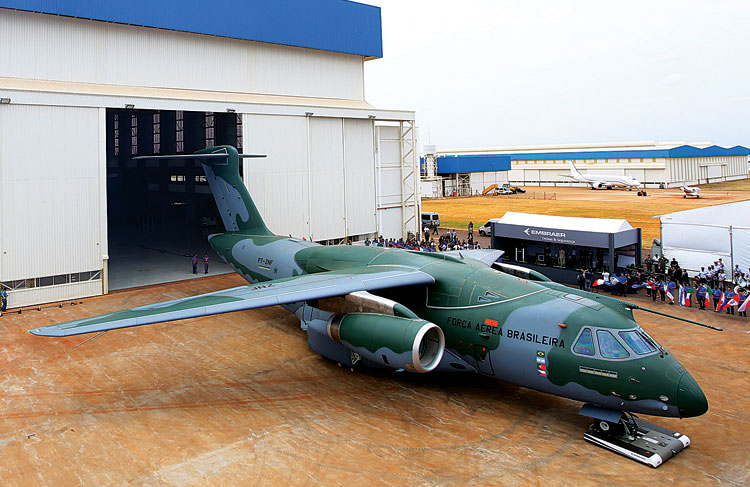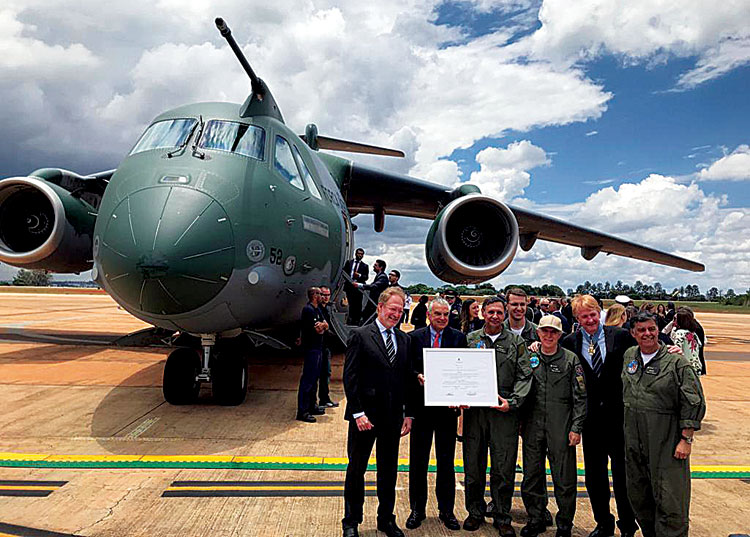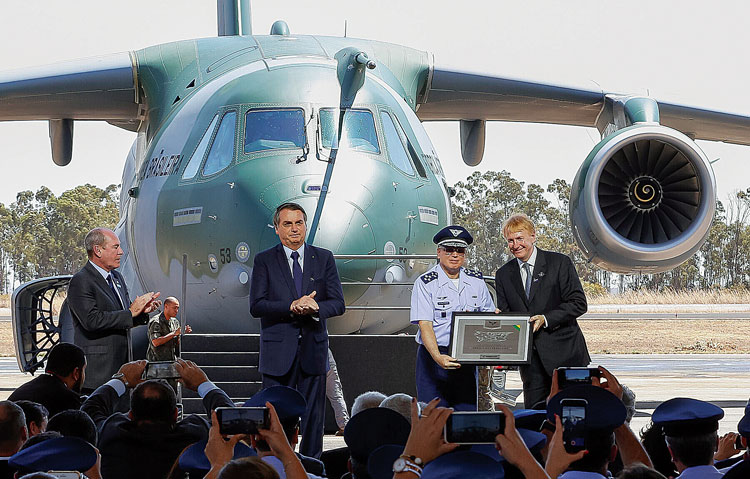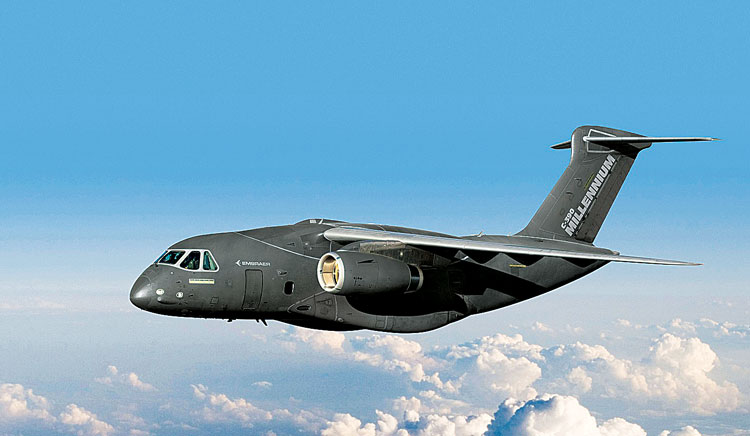INDIAN ARMED FORCES CHIEFS ON
OUR RELENTLESS AND FOCUSED PUBLISHING EFFORTS

SP Guide Publications puts forth a well compiled articulation of issues, pursuits and accomplishments of the Indian Army, over the years

I am confident that SP Guide Publications would continue to inform, inspire and influence.

My compliments to SP Guide Publications for informative and credible reportage on contemporary aerospace issues over the past six decades.
A Versatile Bird from Brazil
The C-390 is the largest, heaviest and most complex military aircraft designed, developed and produced by Embraer and it signifies the level of aerospace technology that Embraer has achieved

Historically, development of medium and heavy-lift military transport aircraft had generally been confined to the aerospace industry of the United States (US), Russia and Europe. However, in April 2007, the Brazilian aerospace major Embraer, declared its intention to develop its first twin-engine, medium-lift military transport aircraft. In March 2008, the Government of Brazil came forward to assist the initial development programme with an investment of about $33 million. Two months later, the Brazilian Congress released $440 million for the development of the aircraft.
C-390 SPECIFICATIONS
PERFORMANCE| Maximum Payload (Concentrated) | 26 metric tonnes | 57,320 lb |
| Maximum Payload (Distributed) | 23 metric tonnes | 50,706 lb |
| Wing Usable Fuel Capacity | 23.9 metric tonnes |
| Maximum Cruise Speed | 470 KTAS /Mach 0.80 |
| Altitude Ceiling | 36,000 ft |
| Sea Level Cabin | 18,000 ft |
| Range with 26 metric tonnes (57,320 lb) | 1,140 nm |
| Range with 23 metric tonnes (50,700 lb) | 1,520 nm |
| Ferry Range | 3,310 nm |
| Ferry Range with internal tanks | 4,600 nm |
| Takeoff Dist (CFL, SL, ISA, 500 nm, payload 23 metric tonnes) | 1,524 m | 5,000 ft |
| Takeoff Dist (CFL, SL, ISA, 500 nm, payload 16 metric tonnes) | 1,165 m | 3,820 ft |
| Vref with 25 klb of useful load | 116 KCAS |
| Normal Landing Dist (SL, ISA, 26 metric tonnes) | 1,000 m | 3,280 ft |
| Length | 35.20 m | 115 ft 5 in |
| Height | 11.84 m | 38 ft 10 in |
| Wing Span | 35.05 m | 115 ft |
| Length (Floor + Ramp) | 18.50 m | 60 ft 8 in |
| Height (Minimum) | 2.95 m | 9 ft 8 in |
| Width | 3.45 m | 11 ft 4 in |
| Volume | 169 m3 | 5,970 ft3 |
| IAE V2500-E5 engines with 31,330 lb of takeoff thrust |
| Rockwell Collins Pro Line Fusion Avionics System |
| Gabbiano Tactical Radar T-20 from SELEX Galileo |
| Cobham 900E Series Wing Air Refueling Pod |
| Rafael Litening II electro-optical/infrared targeting pod |
BACKGROUND
Prior to this proposed venture, in the1970s and early 1980s, Embraer that had been established in 1969, produced highly successful small size military aircraft for basic and advanced stages of training such as the Embraer AT-26 Xavante jet trainer and the Embraer EMB 312 Tucano turboprop trainer. The company also produced the A-29 Super Tucano, a light attack and close air support aircraft. In the large aircraft category, Embraer had produced aeroplanes for the civil aviation industry beginning in 1985 with the EMB Brasilia. Meant largely for the export market, this aircraft was the first in a series of highly successful small and regional airliners. Later, Embraer had produced several models of the E-Jets for civil aviation that have been and are being utilised for regional aviation across the world. The largest in the family of E-Jets is the E-190 that is capable of airlifting payload of 13 tonnes. Since its establishment in 1969, to date, Embraer has delivered a variety of aircraft with the total number being in the region of 9,000.
PLAN TO DEVELOP THE C-390
The newly announced project to develop a military transport aircraft in the medium-lift category, was planned to be undertaken by Embraer in collaboration with and financial support from the Brazilian Air Force known in Portuguese as Força Aérea Brasileira (FAB), that was to be the first customer. As per plans, the aircraft was to be capable of airlifting around 23 metric tonnes of payload and was to have multi-mission capability. The platform was initially christened as the KC-390, but in 2019, it was renamed as the C-390 Millennium, a name that the aircraft carries today. The plan as projected by Embraer was to develop a platform that would be able to compete with the Lockheed Martin C-130 Hercules in terms of performance parameters. One of the objective of Embraer was to replace the fleet of C-130s serving with the FAB. As against the C-130 powered by four turboprop engines, the C-390 Millennium is powered by two jet engines.
As per estimates made in April 2011 by the original equipment manufacturer (OEM) Embraer, there was a large market potential for this newly conceived platform as in their view, 695 military transport aircraft in service of the capability that was planned for the C-390, would need to be replaced during the following decade. Another encouraging factor for the OEM was that in addition to the requirement projected for the C-390 by the FAB, several nations in South America had also expressed interest in this platform.
PROGRESS OF THE PROJECT
In August 2010, Argentina offered to participate in the building of the aircraft. On August 24, 2010, the Defence Ministers of Chile and Brazil signed an agreement for the National Aeronautical Company of Chile, ENAER, to participate in the project. In the same year, Colombia also signed an agreement to join the programme. On December 14, 2011, Brazil and Portugal entered into an agreement for engineering components to be built by Embraer’s Portuguese subsidiary OGMA that provides maintenance services and manufactures aero structures.

Embraer and the US aerospace giant Boeing, signed a cooperation agreement in April 2012 which was upgraded in June that year into a partnership for further development and marketing of the C-390. In this partnership, Embraer held 51 per cent stake with the remaining 49 per cent held by Boeing. There was also a possibility for Embraer to set up a production line in the US that would considerably boost prospects of sale in the highly competitive global market. Unfortunately, as per an announcement by Boeing on April 25, 2020, this arrangement has collapsed. As per some reports, this development is likely to adversely impact prospects of sale of this aircraft in the global market. However, the impact is not likely to be as severe as is being projected as Embraer already has a strong presence globally with its regional jets and has an unblemished record.
SCHEDULE FOR THE PROJECT
On April 14, 2009, Embraer was formally awarded a contract valued at $1.5 billion by the Brazilian government to design, develop and initially produce two prototypes for the FAB. In March 2010, Embraer came up with a schedule that laid down time lines for the development of this new platform. During the Farnborough Airshow in July 2010, the FAB declared its plans to place orders for 28 C-390 aircraft. Meanwhile, Embraer announced upgrade in the payload capability of the platform to 21 metric tonnes. Thereafter, in the following year i.e. 2011, at the Paris Air Show, Embraer announced plans to launch a stretched version of the C-390 in the year 2018. This announcement was related to the potential market in the civil domain where Embraer expected orders for up to 250 aircraft in the next ten years.
EMBRAER C-390 MILLENNIUM: A Timeline
2007
- April 2007: The C-390 development programme was conceived.
2009
- April 14, 2009 - Embraer was formally awarded a contract valued at $1.5 billion by the Brazilian government to design, develop and initially produce two prototypes for the FAB.
2010
- July 2010: At the Farnborough Airshow, the FAB declared its plans to place orders for 28 C-390 aircraft.
- August 24, 2010: The Defence Ministers of Chile and Brazil signed an agreement forthe National Aeronautical Company of Chile, ENAER, to participate in the project.
2011
- April 2011: As per estimates made in April 2011 by the original equipment manufacturer (OEM) Embraer, there was a large market potential for this newly conceived platform as in their view, 695 military transport aircraft in service of the capability that was planned for the C-390.
- June 2011: At the Paris Air Show, Embraer announced plans to launch a stretched version of the C-390 in the year 2018.
- December 14, 2011: Brazil and Portugal entered into an agreement for engineering components to be built by Embraer’s Portuguese subsidiary OGMA that provides maintenance services and manufactures aero structures.
2012
- April 2012: Embraer and Boeing signed a cooperation agreement in April 2012 which was upgraded in June that year into a partnership for further development and marketing of the C-390.
2014
- October 21, 2014 - Embraer rolled out the first prototype of the KC-390 military transport from the production hangar at the industrial plant of Gavião Peixoto, Brazil.

2015
- February 3, 2015 - Embraer successfully performed the first flight of the new military transport and aerial refueling jet, the KC-390. Test pilots Mozart Louzada and Marcos Salgado de Oliveira Lima flew the aircraft for 1 hour and 25 minutes, conducting an evaluation of flying qualities and performance.

2017
- December 20, 2017: The new Embraer KC-390 military transport and aerial refueling jet completed a relevant milestone, with Embraer demonstrating to the FAB , the attainment of the Initial Operational Capability.

2018
- October 23, 2018: The aircraft received a type certification from the Brazilian civil aviation authority, AgênciaNacional de Aviação Civil.

2019
- September 4, 2019: The first production aircraft was delivered to the FAB.

- November 18, 2019: At the Dubai Air Show, Embraer announced the name and designation of its multi-mission medium aircraft, the Embraer C-390 Millennium.

2020
- April 25, 2020: Boeing announced that it has terminated its Master Transaction Agreement with Embraer, under which the two companies had sought to establish a new level of strategic partnership. The parties had planned to create a joint venture comprising Embraer’s commercial aviation business and a second joint venture to develop new markets for the C-390 Millennium medium airlift and air mobility aircraft.
- June 29, 2020: Embraer delivered the third multimission medium airlift C-390 Millennium in the series to the Brazilian Air Force (FAB). The aircraft will be operated by First Troop Transport Group (1st GGT ).

As per the schedule for development, the first prototype was slated to be delivered towards the end of 2014. However, there was a slight delay in the programme. The specified date of delivery could not be met with as the first prototype took to the air only in 2015. The delay of a year was not significant as in the overall perspective, the C-390 took to the air just eight years since the project was conceived – a notable performance by Embraer in the development of modern transport aircraft. On having logged 1900 hours of test-flying during its development phase, on October 23, 2018, the aircraft received a type certification from the Brazilian civil aviation authority, Agência Nacional de Aviação Civil. This civil certificate of airworthiness was formally awarded in a ceremony held at Brasília Air Force Base. The aircraft had already attained Initial Operational Capability (IOC) in December 2017.
The first production aircraft was delivered to the FAB on September 4, 2019 followed by the second. Embraer delivered the third aircraft to the FAB on June 29 this year and is required to deliver another 25.
KEY FEATURES OF THE C-390
The C-390 is the largest, heaviest and most complex military aircraft designed, developed and produced by Embraer to date. As per the OEM, the C-390 comes with the lowest life-cycle cost in the medium-lift category. This platform also signifies the level of technology in the domain of aerospace manufacturing that Embraer has achieved. The C-390 is a high-wing aircraft powered by two IAE V2500-E5 turbofan engines manufactured by International Aero Engines (IAE), a joint venture among leading manufacturers of aero engines such as Pratt & Whitney, MTU Aero Engines and Japanese Aero Engine Corporation. The IAE V2500 engine that delivers a thrust of 139.4 kN, also powers the Airbus and McDonnell Douglas MD90 airliners.
The C-390 aircraft has a tail loading ramp and raised empennage that provides unhindered access to the cargo hold. The aircraft now has a maximum payload capacity of 26 metric tonnes and can air drop 19 metric tonnes of load. It can seat 80 soldiers or 66 paratroopers with full operational gear. The fuselage is large enough to accommodate two armoured personnel carriers and can transport a helicopter as well. The aircraft has the capability to receive fuel while in flight and the Aerial Tanker version can refuel other aircraft in flight through two wing-mounted probe and drogue pods.
LEADERSHIP DURING THE CEREMONY TO HAND-OVER THE FIRST C-390 TO BRAZILIAN AIR FORCE (FAB)

“It is an aircraft that arrived to add to the country and collaborate in the fulfillment of the Air Force mission,” declared President of Brazil, Jair Bolsonaro.

“I am proud, not only as a Minister, but also with a Brazilian citizen, to participate in this moment”, said Minister of Defence, Fernando Azevedo e Silva.

“Today, the largest military aircraft produced in Brazil, the KC-390 (now C-390), is incorporated into FAB. It represents a milestone in the excellence of FAB processes and will certainly boost the Defence Industrial Base in Brazil,” said the Brazilian Air Force Commander, Lieutenant-Brigadier Antonio Carlos Moretti Bermudez.

“We are confident that the KC-390 (now C-390), in addition to successfully fulfilling the missions required by our Air Force, will have a positive economic impact on job creation and new investments in Brazil, as well as high valueadded exports” said Jackson Schneider, President and CEO of Embraer Defense & Security.
Operated by a crew consisting of two pilots and one flight engineer, the C-390 has a cruising speed of 870 km per hour or Mach 0.8 and a range of 2,820 km with a payload limited to 23 metric tonnes. It has a service ceiling of 36,000 ft and a ferry range of 6,130 km. The cockpit sports a dual Head Up Display configuration with dual-control systems for both pilots and has a digital Fly-by- Wire control system that makes handling at low speeds much easier so much so that it can even refuel helicopters in flight.
ROLES BEING PLAYED BY C-390 FOR HUMANITARIAN ASSISTANCE AND COVID-19 PANDEMIC RELIEF ACTIONS
HUMANITARIAN ASSISTANCE
Two aircraft of the Brazilian Air Force (FAB ) took off from the São Paulo Air Force Base (BAS P) on August 12, bound for Lebanon in fulfillment of the mission of Humanitarian Assistance to the Lebanese Republic and landed around 3:40 pm on August 13, in Beirut, capital of Lebanon. The C-390 Millennium carried around six tons of medicines, food and health equipment for emergency care to affected families. The Embraer 190 VC-2 aircraft carried the official delegation, headed by former President Michel Temer. The C-390 Millenium, which performed for the first time an international mission manned only by FAB military personnel, belonged to the First Troop Transport Group (1st GTT ) - Zeus Squadron, based in Anápolis (GO). The pilot of the aircraft, Captain Aviator Phelipe Machado de Souza, explained the versatility of the aircraft, “The C-390 has already been designed for this type of mission, as it has a large load capacity, range and autonomy”..
COVID-19 RELIEF
The Brazilian Air Force (FAB ), in support of Operation COVID-19, carried out on August 16, Logistic Air Transport missions. The C-390 Millennium aircraft, belonging to the 1st Troop Transport Group (1st GTT ) - Zeus Squadron, took off from São Paulo Air Base (BAS P), in Guarulhos, with 10.8 tons of cargo, bound for Manaus (AM) and Boa Vista (RR). The items transported were used to deal with the Coronavirus pandemic. The commander of the aircraft, Lieutenant-Colonel Aviator Luiz Fernando Rezende Ferraz, highlighted the grateful satisfaction in being able to help the population in this moment of confrontation with the new Coronavirus. “Being able to take a large amount of material, with a Brazilian aircraft, is a unique moment and is part of the history of Brazil and the Air Force fulfilling the mission of integrating the national territory,” he said.
ROLE OF THE C-390
Apart from the Brazilian Air Force, there are a number of nations that have indicated their intent to procure this platform in varying numbers for their Air Forces or other agencies. Some of these are Argentina (6), Chile (6), Colombia (12), Czech Republic (2), Portugal (6) and Lisbon-based aviation services firm SkyTech (6).
With medium-lift capability, the C-390 will be employed by the Air Forces primarily in tactical roles such as transportation of troops and military equipment including heavy military vehicles especially where there is urgent need for rapid redeployment. The aircraft can airlift large quantities of cargo or personnel, at high speed, over long distances and with high dispatch reliability. It can also be deployed for maritime patrol as also to carry out in-flight refuelling of other aircraft including helicopters. The platform can be suitably modified to undertake several niche roles such as intelligence, surveillance and reconnaissance missions as well as to operate as a gunship or serve as an electronic warfare platform.
Apart from military tasks, the aircraft can be employed by the nation’s Air Force for a variety of humanitarian missions such as medical evacuation, air drop of vitally needed supplies in case of widespread flooding or other natural disasters, search and rescue missions especially areas that are not easily accessible and to fight forest fires. The C-390 enhances the operational capability of the transport fleet.





